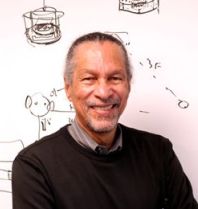Modern Microphones and New Directions in Sensors
James E. West
TUESDAY: February 7, 2012 2:00 P.M. in the H.J.E. Reid Auditorium.
(video) within the Langley firewall only
Abstract
Electret condenser microphones (ECMs) dominate the transducer market for most applications ranging from toys and telephones to professional recording studios but the great advantage of ECMs is stabile repeatable characteristics in larger numbers at low cost. These features opened opportunities to combine multiple units to form arrays ranging from first-order to multidimensional arrays, all aimed at improving signal to noise. ECMs are available in a variety of shapes and sizes ranging from a few millimeters to a few centimeters in diameter. Roughly 2 billion ECMs are made each year throughout the world. Micro electromechanical (MEMS) microphones are even smaller and are currently used in some new cell phones where space is a problem. The use of electrospinning as a poling method to produce piezoelectric fibers offers the possibility of even smaller transducers. Here, we present new piezoelectric nano-fibers based on the biopolymer, poly (ã-benzyl á,L-glutamate) (PBLG). Fabrication of PBLG fibers was made possible by PBLG’s extreme solubility in organic solvents. By simultaneous poling and spinning of PBLG solutions, we fabricated flexible piezoelectric microfibers (diameter: 100 nm) with nearly all of the PBLG dipoles oriented along the fiber axis, evidenced by x-ray diffraction and second harmonic generation. The PBLG fibers showed high piezoelectricity (d33 = 32 pC/N), thermal stability (Tcurie > 100°C), and an elastic modulus of 570 MPa. Due to the versatility in the fabrication process and the high piezoelectricity, the fibers show great promise as nano sensor/actuator material.
Speaker
 James E. West is currently Research Professor at Johns Hopkins University, Department of Electrical and Computer Engineering and the Department of Mechanical Engineering (2002). He was formally a Bell Laboratories Fellow, at Lucent Technologies. His pioneering research on charge storage and transport in polymers (the electrical analogy of a permanent magnet) led to the development of electret transducers for sound recording and voice communication. Almost 90% of all microphones built today are based on the principles first published in the early 1960s. This simple but rugged transducer is the heart of most new telephones and can be found in most microphone applications from toys to professional equipment. West holds more than 50 U.S. and about 200 foreign patents on various microphones and techniques for making polymer electrets and transducers. He was inducted into The National Inventors Hall of Fame in 1999 for the invention of the electret microphone. West is a member of the National Academy of Engineering; a Fellow, and past President, and past member of the Executive Council of Acoustical Society of America (1998-2001), and a Fellow of the IEEE. West is a member of the Board of Directors of The National Inventors Hall of Fame, past member of the National Academy of Engineering’s Committee on Diversity in the Engineering Workforce and a member of the Scientific Advisory Committee of The International Symposium on Electrets. West is the recipient of the Acoustical Society of America’s Silver Medal in Engineering Acoustics (1995), an honorary Doctor of Science degree from New Jersey Institute of Technology (1997). In 2002 he was the Audio Engineering Society Richard C. Heyser Memorial Lecturer. West was awarded the Mexican JOHN WILLIAM STRUTT, 3rd Baron of Raleigh 2003 Award, presented by the Mexican Institute of Acoustics, the Acoustical Society of America’s Gold Medal (2006), an honorary Doctor of Engineering from Michigan State University (2006), the National Medal of Technology (2006) and the Franklin Medal in Engineering (2010).
James E. West is currently Research Professor at Johns Hopkins University, Department of Electrical and Computer Engineering and the Department of Mechanical Engineering (2002). He was formally a Bell Laboratories Fellow, at Lucent Technologies. His pioneering research on charge storage and transport in polymers (the electrical analogy of a permanent magnet) led to the development of electret transducers for sound recording and voice communication. Almost 90% of all microphones built today are based on the principles first published in the early 1960s. This simple but rugged transducer is the heart of most new telephones and can be found in most microphone applications from toys to professional equipment. West holds more than 50 U.S. and about 200 foreign patents on various microphones and techniques for making polymer electrets and transducers. He was inducted into The National Inventors Hall of Fame in 1999 for the invention of the electret microphone. West is a member of the National Academy of Engineering; a Fellow, and past President, and past member of the Executive Council of Acoustical Society of America (1998-2001), and a Fellow of the IEEE. West is a member of the Board of Directors of The National Inventors Hall of Fame, past member of the National Academy of Engineering’s Committee on Diversity in the Engineering Workforce and a member of the Scientific Advisory Committee of The International Symposium on Electrets. West is the recipient of the Acoustical Society of America’s Silver Medal in Engineering Acoustics (1995), an honorary Doctor of Science degree from New Jersey Institute of Technology (1997). In 2002 he was the Audio Engineering Society Richard C. Heyser Memorial Lecturer. West was awarded the Mexican JOHN WILLIAM STRUTT, 3rd Baron of Raleigh 2003 Award, presented by the Mexican Institute of Acoustics, the Acoustical Society of America’s Gold Medal (2006), an honorary Doctor of Engineering from Michigan State University (2006), the National Medal of Technology (2006) and the Franklin Medal in Engineering (2010).